
Source: Huashi Li Huawai
In the past few days, Bitcoin continued to break new highs, reaching a maximum of $123,000, and according to the previously set plan, yesterday (July 14) another 10% of my position was sold. Regarding our own dollar-cost averaging plan during this cycle, previous articles have also shared specific details.
In 2022, we developed a 20-month dollar-cost averaging plan for BTC, insisting on buying BTC monthly, which ultimately concluded (completed) in January 2024, with the average purchase cost of the newly added Bitcoin at around $25,000. Meanwhile, based on our expectations and goals for this bull market (anticipating BTC to reach $100,000–$120,000, with a goal of achieving a 3–5 times return on the overall position), we also customized two selling plans, namely Plan A and Plan B (eventually executing Plan A).
As of now, I have executed 3 sell operations as planned, on December 5, 2024, May 22, 2025, and yesterday (July 14, 2025). According to the original goal plan, I have basically completed the established plan. However, if BTC continues to rise in the next six months, I will also consider selling up to another 20% of my position, while at least 50% of my remaining Bitcoin will be kept in a cold wallet as a long-term asset.
Of course, the above is just my personal position review. Although it's a simple summary, looking back, it seems to represent a kind of stubbornness or persistence of mine over the past few years.
1. The Bull Market is a Great Retreat
Some say the bull market is a great retreat, and this statement is very reasonable.
With BTC continuously breaking new highs in this bull market, reaching over $120,000, if the historical cycle pattern still holds, then it is not ruled out that Bitcoin may enter a 'consolidation or phase bear market' next. Of course, what I am mainly referring to here is phase-based; in the long term, I have always been a die-hard bull on Bitcoin.
Since President Trump formally signed the One Big Beautiful Bill on July 3, Bitcoin has risen more than $15,000, especially in recent days, almost every day is creating new historical highs. This feeling seems to have been experienced last year (2024), if I remember correctly, it should have been around March and November last year.
Some may say: this time feels different. Others may say: the historical cycle patterns of the crypto market have been broken.
But rationality can still remind us that Bitcoin's recent performance is still worth our vigilance, at least we need to seriously be alert to potential risks in the coming weeks (such as possibly within 5–6 weeks).
Here, let’s extend our thinking through the DXY (US Dollar Index) indicators:
Generally, the trend of risk assets is inversely proportional to DXY. In most cases, if the dollar is weak, high-risk assets (like gold and Bitcoin) perform strongly, and vice versa. While we have always been optimistic about Bitcoin, we must also acknowledge one point: currently, gold remains the first choice for safe-haven funds, not Bitcoin.
Let's first look at the comparison between gold and DXY, as shown in the figure below.
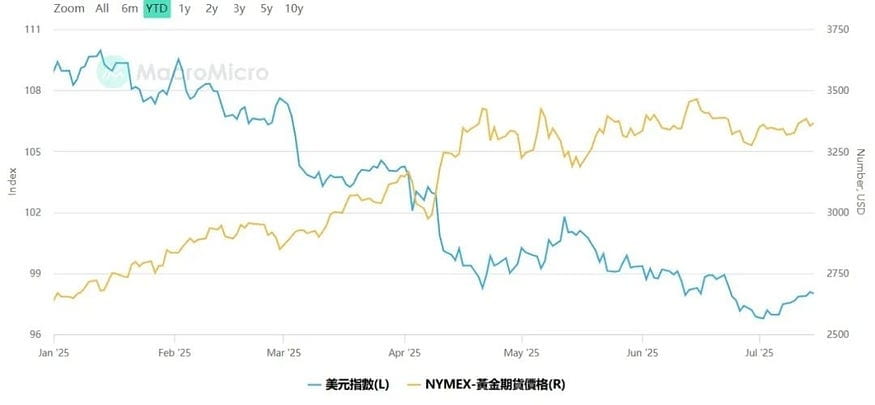
Looking only at the larger trend, it can be seen from the above that since the beginning of the year, as DXY has generally declined, the price of gold has continued to rise, steadily climbing until around April, after which it entered a large-scale oscillation period.
As gold consolidates at high levels, if DXY continues to decline or linger in low ranges, then with some macro policy changes, it is not ruled out that some funds may choose to enter Bitcoin for risk hedging.
We continue to find some clues by comparing Bitcoin & DXY indicators, as shown in the figure below.
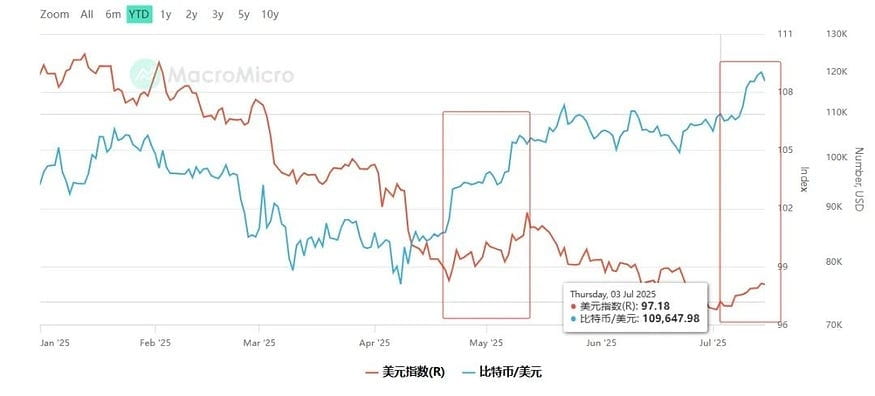
From the above, it can be seen that since the beginning of this year, there are two obvious divergence points between BTC and DXY. The first occurred in April, shortly after Trump announced a 90-day tariff suspension, and the second is this month (July), since the passage of the One Big Beautiful Bill.
To put it more understandably, due to changes in macro factors, Bitcoin's trend seems to decouple from the US dollar index at certain stages, and during a period after each decoupling, Bitcoin continues to create higher historical prices. For example, after decoupling in early April, Bitcoin subsequently created a historical high of $110,000; after decoupling in early July, Bitcoin has now created a historical high of $120,000 (it is not ruled out that it will continue to attempt to break new highs in the next two weeks).
So, could there be a possible situation where, if the existing macro conditions remain largely unchanged, after Bitcoin continues to create new highs, it could re-enter a new round of correction, for example, falling back to around $100,000 in August (that is, within the 5–6 weeks we mentioned above)?
August now seems to be a particularly interesting time point. Here’s a new hypothesis: if Bitcoin indeed undergoes a correction, coinciding with a new policy impact event (like changes in Fed interest rates in September), and BTC and DXY decouple for the third time this year, then theoretically, it cannot be ruled out that Bitcoin will continue to rise and (around October) break historical highs again.
But if the new hypothesis above can really happen, it theoretically may continue to imply that, without seeing any more significant macro impact events this year, the new high in the fourth quarter is likely to be the last high of this bull market, and thereafter we may truly welcome a relatively long phase of 'bear market'.
Of course, all of the above are merely our speculations and guesses based on certain data perspectives and theoretical levels. As for how Bitcoin will specifically move next—will it begin to enter a new stage of 'consolidation or phase bear market'? Or completely break the historical cycle pattern and enter a super 'long bull cycle'? We'll leave that to time.
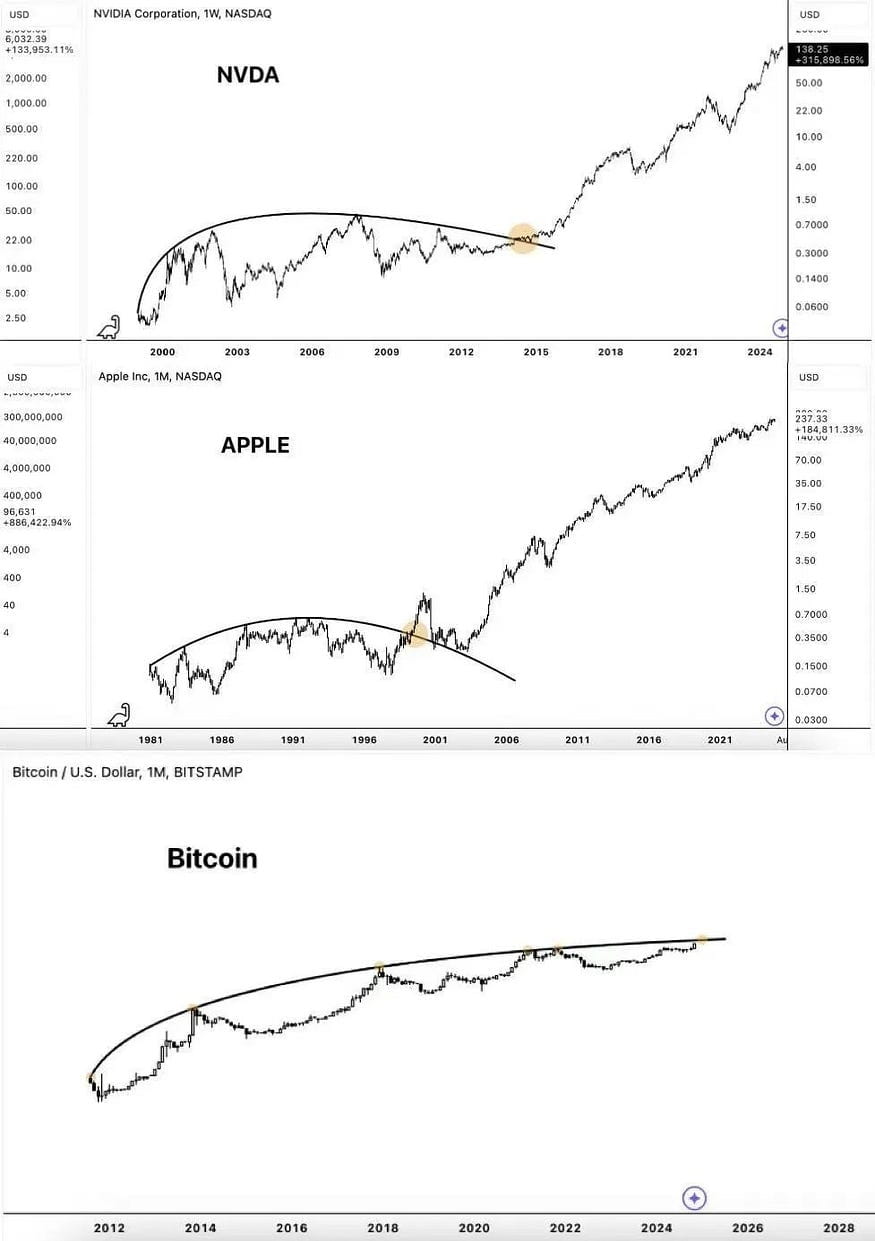
2. Institutional Capital and Crazy Bitcoin
In previous articles, we also discussed that the price of Bitcoin in this bull market seems to be mainly driven by institutions, with more and more institutional capital directly or indirectly chasing this wave of Bitcoin's rise.
For example, after the BTC ETF was approved, BlackRock's IBIT (iShares Bitcoin Trust) took over a year to reach a record $83.5 billion in assets under management, accumulating over 200,000 BTC in assets. As shown in the figure below.
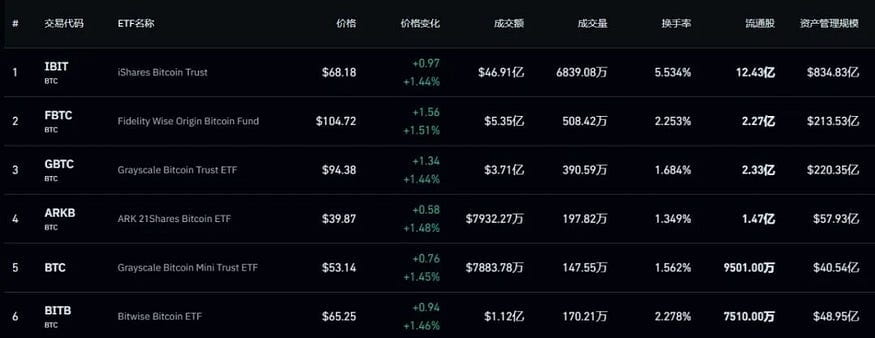
The world's largest gold ETF, GLD (SPDR Gold Shares), took 20 years to reach the same milestone.
Earlier on, the crypto market was mainly dominated by retail investors. Since the last cycle, retail investors have begun to realize that more and more traditional institutions (like Tesla) have entered the market. In this cycle, more institutional capital, hedge funds, and family offices have begun to study or participate in the cryptocurrency space, even those once 'conservative' funds seem to be considering allocating 1% of their assets to Bitcoin.
According to a report from the KobeissiLetter, the current scale of institutional assets under management in the US is about $31 trillion. If 1% of American institutional capital flows into Bitcoin, it could also push the asset to flow back in by about $300 billion or more. Considering global institutional AUM, we may see over $1 trillion flowing into Bitcoin in the future. As shown in the figure below.
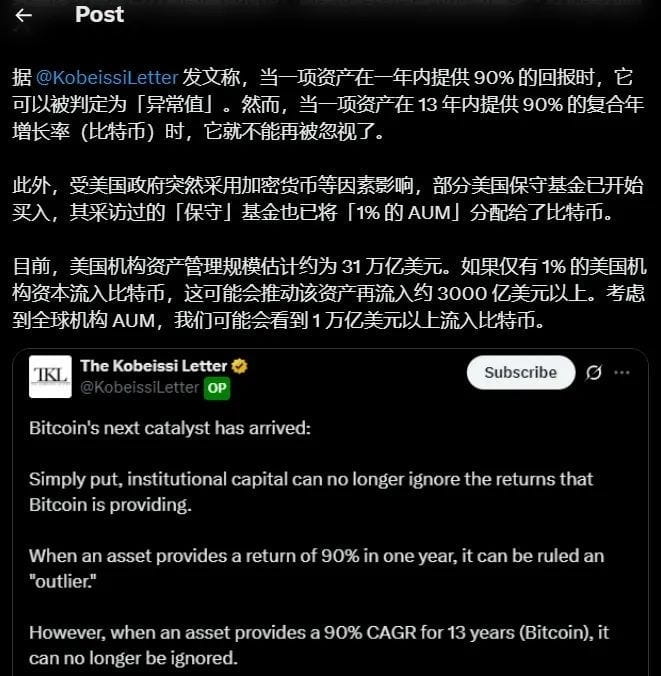
I asked ChatGPT to calculate, if $1 trillion continues to flow into Bitcoin, then in the future, Bitcoin's price could rise from the current $120,000 to $250,000–$340,000 (not including speculative funds accelerating their entry).
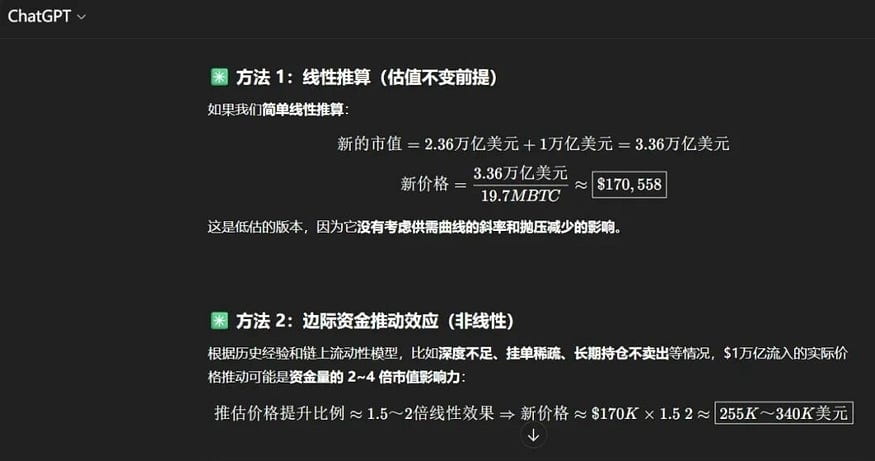
And this number seems to be similar to our previous article's expectations (speculations), that is: Bitcoin might reach $300,000 by 2029.
In conclusion, we reiterate a saying from previous articles: if your goal is long-term and you firmly believe in Bitcoin's future, then it is always a good time to buy (accumulate) Bitcoin now. However, if your goal is medium to short-term, then you need to stay alert to market volatility and make choices that suit your risk preferences.
Additionally, as we mentioned above, Bitcoin may start to enter a new 'consolidation or phase bear market', but this may not be bad news for altcoins. As we mentioned in the previous article (July 12) on the topic of altcoin season: with Bitcoin's continued new highs and entering consolidation, this could bring about a new round of 'mini altcoin season' opportunities.


